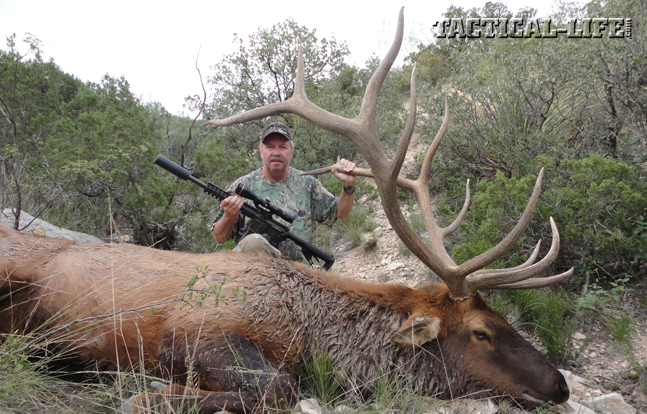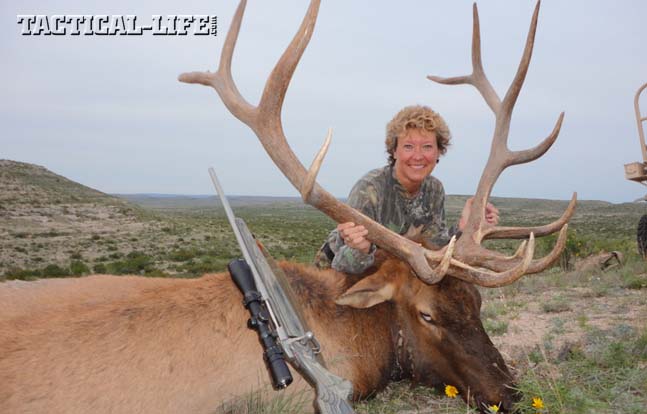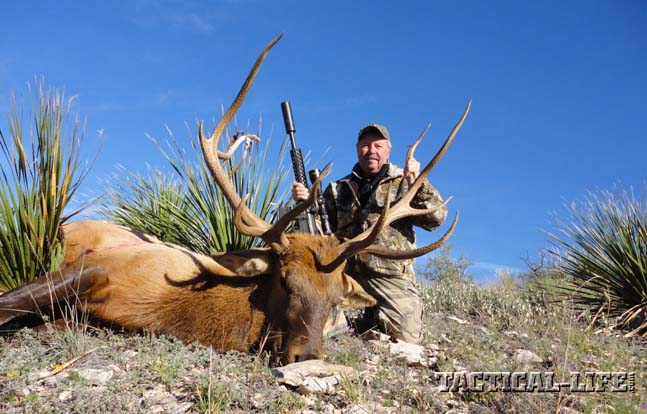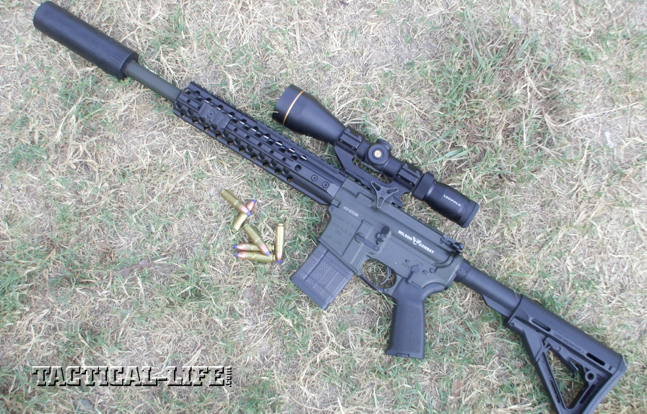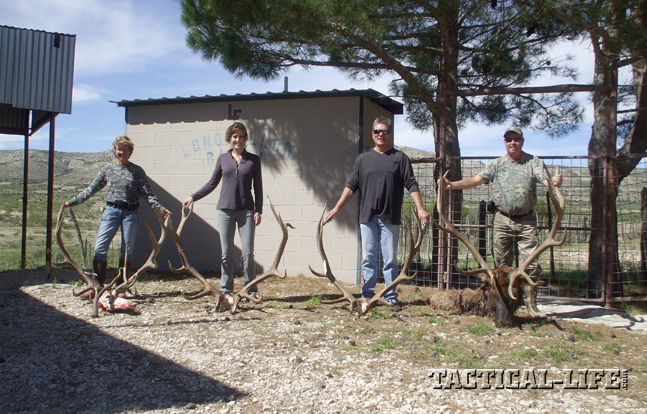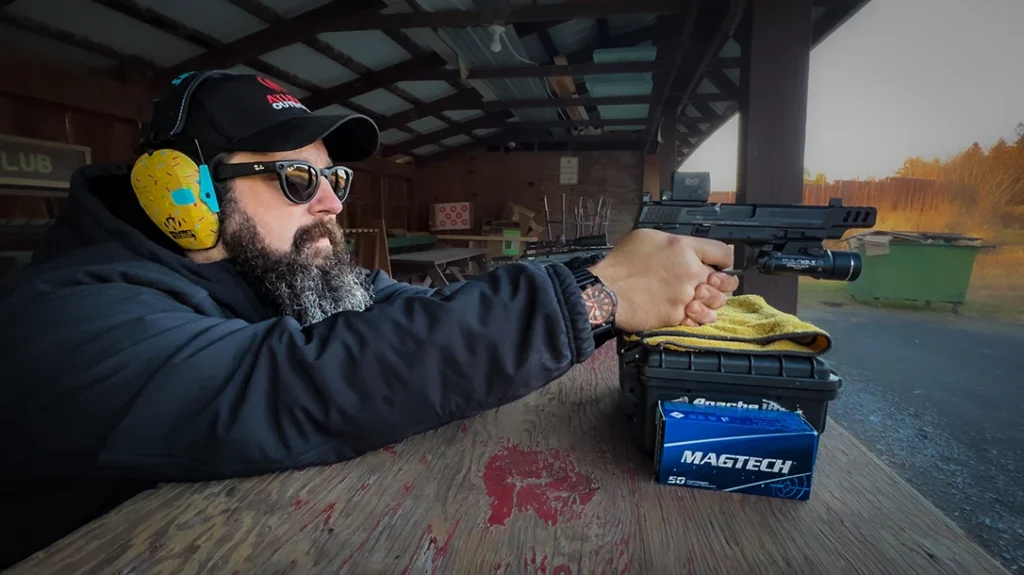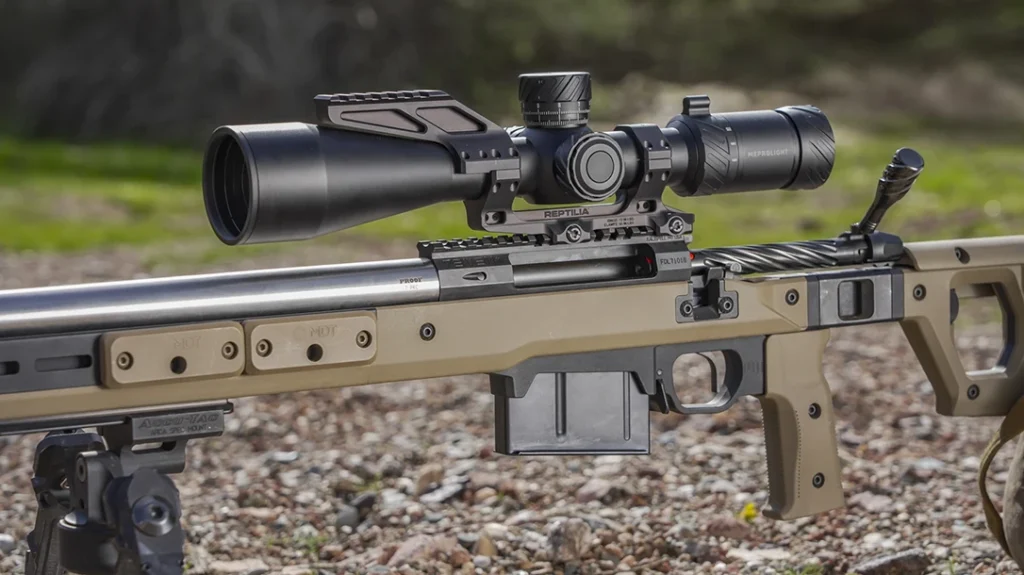Joyce Wilson had never before shot an elk, but when she found herself within range of a 7×6 trophy bull during the first hour of her first hunt in October 2012, she didn’t hesitate to pull the trigger. “I’ve been on enough hunts to know that if you pass up the first big animal you see, there’s a good chance you’ll never see anything like it again,” she said. “I’d never hunted elk before, but one of the bulls we were watching was nice—pretty darned nice, in fact. So I took him.”
Joyce Wilson, executive director of the International Defensive Pistol Association (IDPA), was hunting on the Longfellow Ranch in West Texas with her husband, Bill Wilson, owner and founder of Wilson Combat. The Wilsons live about 100 miles east of Dallas, but had never heard about the Longfellow Ranch and its wild, unfenced, free-range elk herds until stumbling onto the topic while talking with a neighboring friend.
After making a phone call or two, Bill decided he and Joyce had to book this unique hunt in Texas’ harsh, arid hills about 35 miles south of Fort Stockton, Texas, and 70 miles north of Mexico. Besides, he and Joyce had never shot an elk, and he openly says he’s a man of lightweight jackets who’s not into horses, mule trains and packing elk out of snow-capped mountains in blizzards and sub-freezing temperatures.
Advertisement — Continue Reading Below
So, the Wilsons were happy to find T-shirt weather when they arrived at the Longfellow Ranch about mid-afternoon in mid-October last fall for their five-day hunt. By the time they shot their rifles to verify they were sighted in, they had roughly 90 minutes of daylight remaining. Their guides said that would be enough time to check out some sites on the ranch’s approximately 350,000 acres.
Sako Takedown
Joyce’s guide, Randall, had spent his life working on the ranch, including many years as a trapper hired to remove coyotes and bobcats to protect the ranch’s cattle and calves.
Advertisement — Continue Reading Below
“We climbed into these really cool dune buggies and took off,” Joyce said. “He really knows the ranch and where elk often hang out. We drove straight to one of the areas and bugled to see if we could locate them. We got an answer right off, but it was out there a ways. We got back into the dune buggy, drove a bit farther and bugled again.
Those elk were really fired up! So we got out and started stalking to see if we could locate them.”
The West Texas terrain features rocks, rugged hills, steep canyons, relatively few trees and thick patches of nasty brush, all of which can make for difficult walking. But those same traits also make it possible to stay hidden while stalking into rifle range.
Advertisement — Continue Reading Below
“As we moved in, we spotted a herd with bulls on a hillside above us,” Joyce said. “It was right before dark, so I knew I’d have to decide fast if I wanted to shoot one of the bulls. And once I decided which one to shoot, I didn’t want him to go far. None of us wanted to go tracking all night.”
Joyce said she felt confident, though. For this hunt, she was using a Sako 85 bolt-action rifle in .30-06 with a 2.5-10×40 Bushnell Elite riflescope and 180-grain Barnes TTSX bullets. She was able to get within 150 yards of the elk before setting up for the shot.
“I had about a 140-degree uphill angle, so I sat down and rested my rifle on my shooting sticks,” Joyce said. “After I shot, he took about three steps and went down, so I was very happy. Then we spent the next couple of hours cutting him up and packing it over to the dune buggy. That wasn’t too bad, though. We were able to get the buggy within about 50 yards of where he fell.”
Advertisement — Continue Reading Below
Bill’s Big Bull
Bill’s hunt for a trophy bull took only a few hours longer, not counting the full night’s rest at the ranch. He and his guide left the ranch at dawn the next morning in a dune buggy and headed for another area where elk had been active in recent days. Wildlife managers estimate about 1,200 elk live on the sprawling ranch, and they’re known to range for miles on any given day.
By moving from site to site and bugling at each stop, they were soon covering lots of ground to locate a big bull. For his hunt, Bill chose a 14.7-inch-barreled Wilson Combat Recon in .458 SOCOM with a Whisper suppressor and 300-grain Barnes TAC-TX bullets. He topped the rifle with a Leupold VX-R 3-9×50 riflescope.
“I wanted to shoot my elk with one of our guns, so I called and talked to the guy in charge to ask if 150-yard shots would be possible out there,” Bill said. “He assured me there’d be some good chances at that range, but we’d have to do some spotting and stalking. I’ve been using that caliber and load on wild hogs quite a while and found it very effective, so I knew it would be adequate for elk.”
Advertisement — Continue Reading Below
Bill and his guide spotted elk during the first hour or so of daylight, but nothing tempted them to stalk closer. Before long, however, they bugled and glassed from a spot with good views of distant hillsides. As they studied one of the brushy slopes, they spotted elk moving downhill into a canyon and knew at least one of the bulls would be worth a long hike.
The guide knew the canyon where the elk were headed, so they jumped from the dune buggy and hustled through a mile-long stalk, hoping to put themselves in the herd’s path. The plan worked perfectly. Bill and his guide saw antlers moving out of the canyon just as they settled into a good vantage point shortly before 8:30am.
“The first bull wasn’t the one we wanted,” Bill said. “We watched it walk by, and soon after the big guy walked out and gave me a clear shot at 65 yards. He was broadside, heading to my left, so I whacked him in the shoulder. When he spun around and moved away, I shot him behind the shoulder. He didn’t take another three steps before he fell and rolled all the way to the bottom of the canyon. He took a long, hard fall through a lot of rock, but he only knocked one chip out of his antlers.”
Advertisement — Continue Reading Below
Unlike Joyce’s trophy bull the night before, Bill’s giant 6×6 proved difficult to get back to the ranch. In fact, when seeing where it ended up, Bill and his guide returned to the ranch to round up extra hands. They returned with three helpers and got a dune buggy within 75 yards of the bull, but the rugged terrain still made for backbreaking labor. “That was a bit of a problem,” Bill said. “We had no choice but to cut it into pieces and haul it up and out of there.”
Game Management
The Wilsons weren’t done, however. Their hunt at the Longfellow Ranch also allowed them to take a “management” bull, which proved more difficult and time-consuming than their hunts for the big bulls.
Advertisement — Continue Reading Below
“We saw a lot of big bulls, so that wasn’t the problem,” Bill said. “I even passed up some good bulls before shooting the one I wanted. But management bulls had to meet certain management criteria. You had to find a bull with something wrong with its antlers, whether it was the right width or something messed up with the antlers. We looked all over that ranch for the right bull the next few days. We did a lot of looking and glassing to find one that met the requirements.”
In fact, Bill needed every day of his five-day hunt before shooting his second bull. And when he and his guide found that special bull, a 5×6, it didn’t make things easy. “When we spotted him and knew he qualified as a management bull, he was a good distance away and we couldn’t approach him from where we were,” Bill said. “We had to go all the way around the canyon and come in from the other side. When we finally got into position, he had moved into the bottom of the canyon. We circled in behind him and moved a few hundred yards closer, but we couldn’t get any closer than 183 yards. That’s farther than I had planned to shoot with that gun.”
After studying the situation, Bill felt confident he could make the shot. He knew the load’s trajectory, so he settled in and fired. The big bullet flew true and passed through the bull, which went only 20 yards before crumpling in open terrain. This time they were able to drive right up to the bull and haul it back to the ranch.
Advertisement — Continue Reading Below
Joyce, meanwhile, found her management bull on the third day of her hunt. Hers, too, however, proved difficult to pin down. The guides had seen a bull with an odd four-point configuration for a left antler, and a disfigured right antler with two tines, one of which looked like a black club angling downward beside its right eye.
They described the bull to her to see if she was interested in hunting it, but warned her it might be difficult to find this specific bull in land so vast. “The description of those antlers sounded weird, and I knew we’d be looking for a needle in a haystack, but I figured, what the heck—let’s try it,” Joyce said. “Elk are always moving around, and it’s hard to predict where they’ll be each day. All you can do is go out there and try to find them.”
After having no luck the first and second full days of her hunt, Joyce and her guide finally located the odd-antlered bull the third morning. “We were driving along the tops of some hills and stopped to bugle from one of the hilltops,” Joyce said. “We heard a bull bugle back, and went toward the edge of the hill and looked into the ravine. There they were. There was a small herd, and he was with them.”
The distance was about 80 yards, and Joyce made another DRT (dead right there) shot. “Shooting him was kind of anticlimactic because it ended up being an easy shot,” Joyce said. “The real fun was hunting him for three days and finally finding him. That was fun because I saw a lot of country on the ranch. It helped me appreciate how well my guide knew the property and where to find elk in all that country.”
The Wilsons were not only impressed by the property’s elk and wild terrain, but also the staff and accommodations of the Longfellow Ranch. The ranch is located in the “Big Bend Country” of West Texas, and also offers guided hunts for mule deer. Its lodge measures 4,700 square feet, and offers five-star room and dining facilities for hunters and other guests who come there for hiking, scenic wildlife tours and five-stand shotgun shooting.
Honey Badgers to Lions
This might have been the Wilsons’ first elk hunt, but they’ve hunted far and wide during their lives, including trips to Africa where they’ve taken everything from honey badgers to lions. And even though most people think of the Rocky Mountains when picturing bugling bull elk, the Wilsons can’t imagine a more impressive region than West Texas for elk hunting.
“Parts of that ranch have unbelievable sights,” Bill said. “You can see this vast area of more than 120,000 acres with rugged hills and deep canyons. Plus, we were there during the rut, and the bulls were bugling. And it was my kind of hunting. It was a little chilly early in the morning and after dark, where you needed a light jacket. And you needed a heavier jacket when driving back at night, but during the day you just needed a shirt. We couldn’t have ordered nicer weather.” For more on Longfellow Ranch, visit longfellowranch.com or call 432-395-2966. For more on Wilson Combat, visit wilsoncombat.com or call 800-955-4856.
